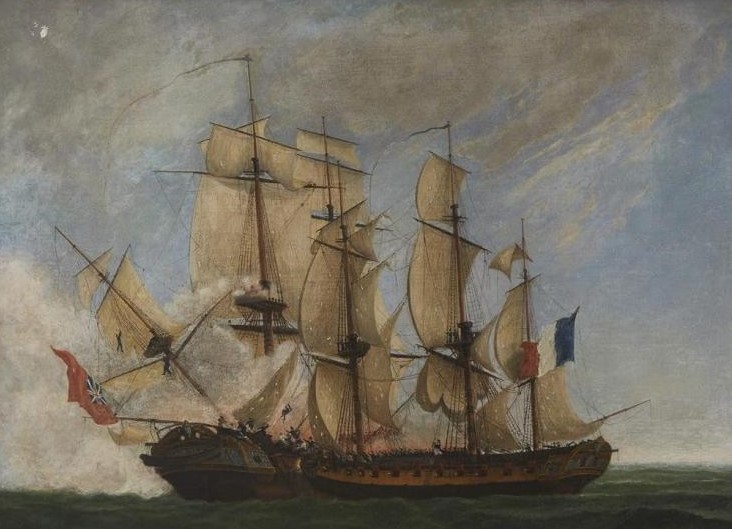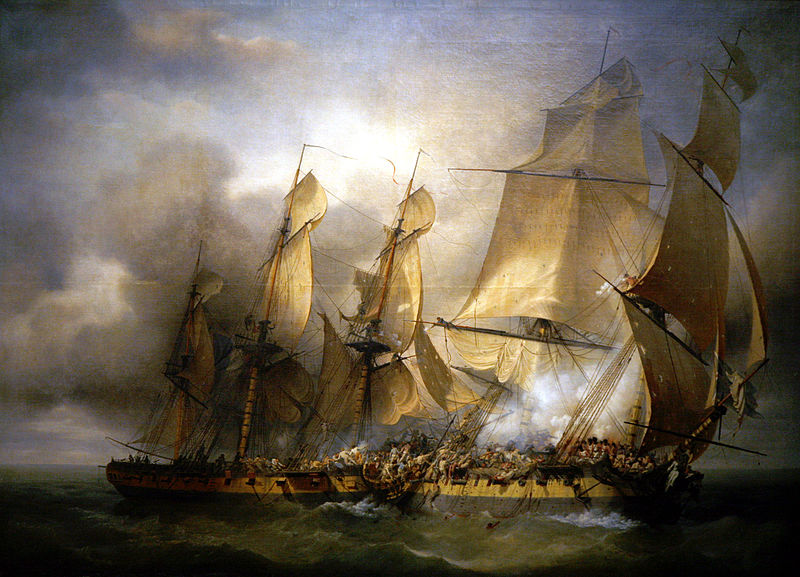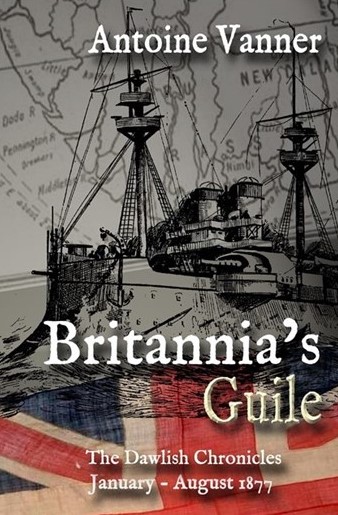The Bayonnaise and HMS Ambuscade action, 1798
On my blog I have dealt several times with single-ship actions during the Age of Fighting Sail, the protagonists being mainly British and French, though the Americans do figure in 1812-15. In most cases British victory over the French seems to have been all but pre-ordained, for the Royal Navy had reached a peak of professionalism in this period and the French officer corps had suffered badly in the revolution, a setback from which it never fully recovered. It is therefore somewhat of a surprise to learn not only of a French vessel, the Bayonnaise capturing a British one, HMS Ambuscade, in a single-ship action, but also that the French vessel was significantly smaller and less powerful.
 The climax of the action. Bayonnaise (R) rams HMS Ambuscade and the latter’s mizzen falls
The climax of the action. Bayonnaise (R) rams HMS Ambuscade and the latter’s mizzen falls
Painting by Jean Francois Hue, 1751-1823
HMS Ambuscade was, by contrast, much more powerful, a 32-gun frigate that had seen successful service against the French in the American Revolutionary War. Though her dimensions were generally similar to the Bayonnaise , and though she carried a similarly sized crew, her armament was considerably heavier – 26 twelve-pounders, a total of eight six-pounder bow and stern chasers, four eighteen-pounder carronades on the quarterdeck and two on the forecastle. In any ship-to-ship action between the two vessels the Bayonnaise might have been expected to have little chance of survival.
From August 1798, at a time when the Royal Navy’s blockade of the French coast was becoming ever more effective, HMS Ambuscade, commanded by Captain Henry Jenkins, was ordered to patrol off the French Atlantic coast. At dawn on 14th December, when she was cruising off the Gironde estuary, and expecting to meet HMS Stag, she sighted a sail. Assuming this to be the Stag, she steered closer. The newcomer was in fact the Bayonnaise which, significantly as it later proved, was carrying a 40-man army detachment in addition to her own crew. The French ship, recognising that she was outsized and out-gunned, went about and fled. A stern-chase ensued and it was not until noon that the range closed sufficiently for the first shots to be fired.
The action might have ended when HMS Ambuscade crossed Bayonnaise’s stern. This was the most vulnerable part of any sailing man-of-war, as shot crashing through the stern could run longitudinally along the entire inner decks, destroying all in their path. The manoeuvre, if successfully executed, was the deciding factor in many naval battles. It was at this moment of greatest risk that Bayonnaise’s luck kicked in. One of HMS Ambuscade’s 12-pounders burst, killing thirteen around it and destroying the vessel’s boats. In the ensuing confusion Bayonnaise headed south and a new stern chase developed. HMS Ambuscade, recovered from her setback, drew level in mid-afternoon – when, on this winter’s day, only a few hours of daylight still remained.

The moment of ramming (note damage to sails) – by naval artist Antoine Roux (1765-1835)
HMS Ambuscade was now sailing parallel to Bayonnaise and well placed to batter her to fragments. Desperate measures were called for if the latter was to survive. Richter, her captain, ordered sail to be backed and swung the helm hard over to port, smashing into HMS Ambuscade’s starboard flank close to the stern. Bayonnaise’s bowsprit crashed into the British frigate’s mizzen mast. It fell, and the tangle of cordage and wrecked spars locked both vessels together.
The extra men Bayonnaise carried – soldiers, accustomed to handling muskets – now proved decisive. A withering fire was directed on Ambuscade’s deck, so many of her officers being wounded that only a single lieutenant was left in command. Bayonnaise too was taking casualties – Captain Richter had an arm shot off – but the advantage now lay with her. French seamen and soldiers clambered across the bowsprit on to Ambuscade and a savage melee developed. Bayonnaise’s new-found luck continued, for a powder charge exploded on Ambuscade’s quarterdeck, inflicting yet more casualties. The fighting continued for another half-hour, but numbers told. When HMS Ambuscade’s colours were finally struck it was by her purser, the last Royal Navy officer still in action.

The most dramatic – and magnificent – representation of all
French boarders can be seen storming across the bowsprit to the Ambuscade
Painting by Louis-Philippe Crepin (1772-1851) in the Musee National de la Marine in Paris
The butcher’s bill for this action was 15 killed and 39 wounded on HMS Ambuscade while Bayonnaise had 25 killed and 30 wounded. The captains of both vessels were among the wounded, and many other officers beside. It should be borne in mind that “wounded” often implied the necessity of amputation of limbs and that death by gangrene was a serious possibility thereafter. As was normal when a captain lost his ship, Captain Jenkins was later court-martialled, though he was exonerated, despite what many considered poor leadership and tactical manoeuvring.
Both vessels were to have active careers thereafter. HMS Ambuscade was taken into French service as Embuscade – wooden ships were almost infinitely repairable if they had not exploded, burned or been sunk. She was however recaptured in 1803 by no less a prestigious ship than HMS Victory, and she resumed her old name. She had an active and successful career thereafter until she was broken up in 1810. Bayonnaise’s luck ran out in 1803, the same year in which Ambuscade/Embuscade’s turned for the better. Run down by HMS Ardent off Cape Finnisterre, her crew burned her rather than surrender.
French pride in the Bayonnaise/Ambuscade action was unbounded – probably because such victories were rare – and eminent artists of the time produced dramatic paintings of it. They convey much of the excitement and drama and some have been used to illustrate this article.
The new Dawlish Chronicles novel is published
Britannia’s Guile
 1877: Lieutenant Nicholas Dawlish is hungry for promotion. He’s chosen service on the Royal Navy’s hazardous Anti-Slavery patrol off East Africa for the opportunities it brings to make his name. But a shipment of slaves has slipped through his fingers and now his reputation, and his chance of promotion, are at risk. He’ll stop at nothing to save them, even if the means are illegal . . .
1877: Lieutenant Nicholas Dawlish is hungry for promotion. He’s chosen service on the Royal Navy’s hazardous Anti-Slavery patrol off East Africa for the opportunities it brings to make his name. But a shipment of slaves has slipped through his fingers and now his reputation, and his chance of promotion, are at risk. He’ll stop at nothing to save them, even if the means are illegal . . .
But greater events are underway in Europe. The Russian and Ottoman Empires are drifting ever closer to a war that could draw in other great powers. And Britain cannot stand aside – a Russian victory would spell disaster for her strategic links to India.
The Royal Navy is preparing for a war that might never take place. Dozens of young officers, all as qualified as Dawlish, are hoping for their own commands. He’s just one of many . . . and he lacks the advantages of patronage or family influence. But only a handful of powerful men know how unexpectedly vulnerable Britain will be if war comes. Could this offer Dawlish his chance to advance?
Far from civilisation, dependent on a new and as yet unproven weapon, he’ll face a clever and ruthless enemy in unforeseeable and appalling circumstances.
Only stubborn resolution – and unlikely allies — can bring him through. But at what price?
Britannia’s Guile is set early in the Dawlish Chronicles series (directly ahead of Britannia’s Wolf) and tells how Dawlish met several people who will play major roles in his future career. And they may not all be as they seem . . .


